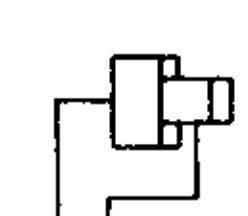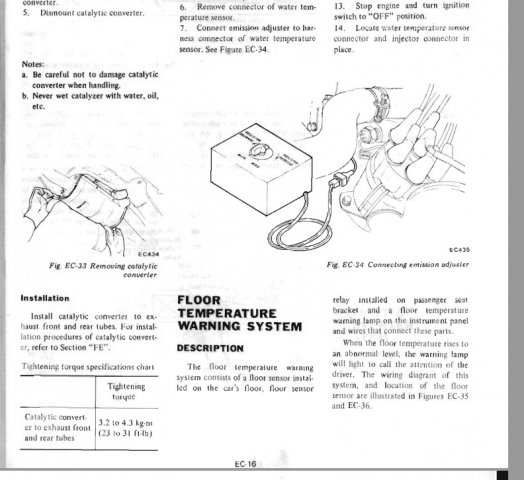
NewZed
Members-
Posts
6700 -
Joined
-
Last visited
-
Days Won
72
Content Type
Profiles
Forums
Blogs
Events
Gallery
Downloads
Store
Everything posted by NewZed
-
Does the shift lever go side-to-side like it should but not back and forth or does it not move at all except to drop down in to 4th or reverse? Describe how it seemed to be functioning just fine when it seemed to. You can always pull the transmission from the bottom if you get the engine hooked up and can't fix the problem.
-
-
Is it a Pathfinder? Or a Maxima?
-
I have only worked with the FSM's like the one in the link below. Your picture looks like it came from an FSM for a more modern car, with a more modern font and more modern parts. Kind of weird. Good luck with it. Added a picture from EC-16 of the 1975 FSM. Maybe there's a separate FSM for California, although the 1976 Owners Manual (can't find a 75) also refers to a floor Temperature Sensor, not a converter temperature sensor. Edit - by the way, even if you do have an updated more modern, specialized FSM for your car, it should still have a full description of what the ECU uses to determine fuel enrichment, in the Engine Fuel chapter. It will tell you if the catalytic converter temperature sensor is involved. It shoudn't be though, unless it's using it's reading as a proxy for O2 sensor temperature, which I don't think you would have in 1975. http://www.nicoclub.com/FSM/280z/1975/ http://www.xenons30.com/reference.html (page 3 of the 1976 Owners Manual)
-
To 280zex - You have the ZX fuel rail cooling setup, I see, pointed generally at the carburetor. Is it on a temperature switch or manual, and when does it come in to play? Just curious.
-
The price will depend on how accurate you want the work to be. Some machinists will look at it and say "that is a critical area for proper operation and durability and will take time to set up to provide the accuracy and precision to do it right - could be expensive". Others will look at it and say "two holes and some grinding, that's a piece of cake". Here's that Ermish guy's web site - http://www.ermish-racing.com/
-
You missed my point on the fuel mileage (but got it at the end of your post). You don't really know what it is, you're just assuming based on the gauge needle moving a small amount, and the odometer number changing. And who knows if the odometer reads right. Post a page number or a picture of the FSM's reference to a catalyzer temperature sensor (the Nissan Factory Service manual, not a Chilton or Haynes book). I've never seen the sensor so don't know what it looks like, but I've also never seen a reference to it for a 1975 USA market car. Sounds interesting. It would help you to know if your car is a Federal model, or California, or imported. They have differences. If you have an adjustable FPR you could drop a couple of PSI to change the rate of the Ford injectors. Also noticed your bungy cord battery hold down with the battery on its side. It doesn't even have to come completely free to short out, just slide forward a few inches. Your problems are set to grow dramatically with one hard braking situation. http://www.rceng.com/technical.aspx
-
Those injectors are in the ballpark. Stock is 188 cc/min (17.9 lb/hr). 6% too much fuel. 1975 doesn't have a "catalyzer temp sensor", but it does have a floor temperature sensor. It's only function is to tell the driver what is causing that smell,so that they can have their converter checked. 1975 didn't use an O2 sensor for engine management, so if you had an O2 sensor installed, it was added later. Finally, 75 miles on a half tank could just be a bad fuel level gauge. You might be worrying about nothing. Getting real numbers will make you feel more secure.
-
Clutch problems again...
NewZed replied to egzlilgituarboy9's topic in Gen I & II Chevy V8 Tech Board
What kind of help are you looking for? You put everything together and the parts worked correctly, as implied by the fact that you started the engine, shifted in to gear and drove. Then something changed and now you have a problem. So you could assume that you had a part failure or something came loose. Or that you're beating yourself up with the wrong set of parts, that are breaking because they're not designed to work togther. Since it's broken three times before this seems highly possible. And what do you mean by "pivot ring was out"? And how do you know? -
"123 Ignition" Distributor Replacement for Nissan L4/L6
NewZed replied to Tony D's topic in Nissan L6 Forum
Shouldn't a good Hybridz member be able to look at the diagrams on the Dutch site, pick the best distributor model, then modify/fabricate to make it work? They give all of the critical dimensions.- 30 replies
-
- Programmable Ignition
- Megasquirt
-
(and 3 more)
Tagged with:
-
Click on "More Reply Options", then "Browse" under "Attach Files". You should be able to figure out picture posting from there.
-
Re-read your post and can't tell what you changed between the time it ran well and now. The problem is probably tied to the changes.
-
Gasoline can go bad within a year. It loses volatility. Doesn't ignite well.
-
Nightmare Fairlady 280z fuel problems
NewZed replied to Nightmare_Fairlady's topic in S30 Series - 240z, 260z, 280z
You mean the EFI, or main, relay, right? The EFI rely and the fuel pump relay are combined in the same container for 75-77. It helps to distinguish the two when troubleshooting, especially since the FSM separates the two functions. You could disconnect the wire to the fuel pump and install a completely separate relay, but you'd still need the main relay to power the EFI system. -
See what they go for in the local wrecking yards, then add a premium for being able to hear it run. That's how I would see it if I was buying.
- 7 replies
-
- 1978 280z
- 280z engine
-
(and 1 more)
Tagged with:
-
Nightmare Fairlady 280z fuel problems
NewZed replied to Nightmare_Fairlady's topic in S30 Series - 240z, 260z, 280z
You might have the "I've done so many things I can't remember exactly what I did" problem. Still, confirming the basics won't hurt. Engine Fuel chapter in the FSM. Get a multimeter. Your replacement pump should put out about 2.5 times the pressure the engine needs. -
But EDIS may not be needed, right? "megasquirt" comes in many flavors.
-
Pretty ingenious but there is a reason that they section strut tubes. Three and four inches of lowering seems guaranteed to bottom out your shock absorbers. You'll be bouncing down the road like a bad Honda. And how much force will those clamps take without slipping. You're depending on the friction between shiny new clamp steel and 40 years of rust, at the limited contact area between the two. Not safe at all, you could easily be dragging frame rail after a hard bump. Add a little rain water and it's even more likely.
-
'75 L28 not starting after sitting.
NewZed replied to Blf0005's topic in Trouble Shooting / General Engine
Find out if it was a typical "ran when parked " car or if it was parked because it was dead. If it was dead when parked, you could waste a lot of time on how to start a an engine that hasn't run for years. Use the manual along with the handbook and you should be able to blow through all of the testing you need to do in a day. http://www.nicoclub.com/FSM/ -
KA24DE in 280z with stock transmission vs swapped transmission
NewZed replied to ChickenCoupe's topic in Nissan 4 Cyl Forum
I've never heard of an L6 snapping a crankshaft. I get most of my information from the world-wide web though. Do you have any examples? And I've read about quite a few L6 head gasket problems. Some pictures or links would be interesting. Always looking to learn something new. -
Well, he seems to know what he's doing in the video. Maybe not.
-
Nightmare Fairlady 280z fuel problems
NewZed replied to Nightmare_Fairlady's topic in S30 Series - 240z, 260z, 280z
You kind of have the "maybe I did too much at one time" problem. The engine ran with the wiring to the old fuel pump (for one day at least), assuming that it was a bad pump that caused it to stop running after one day. But now you have a new pump and modified wiring. Would have been more clear if you had installed the new pump with the old wiring, then fixed the wring afterward. But you are where you're at so the best you can do is run through the basics - confirm that you have spark, confirm that the injectors are firing, etc. Your bucket test shows fuel flow, but not pressure, so if you're not going to measure pressure all you have are the other things. Your question about what needs to be plugged in and what doesn't are all described in the FSM. Maybe your bad wiring shorted and took something else with it, like the ignition module or the ECU. Run through the basic tests in the Engine Fuel chapter and something will show up. "Have fuel, engine won't stay running" could be caused by all kinds of problems. And you forgot to identify year of car in this new thread. -
Thanks for that. The RB engine seems so much more sophisticated than the L, it's weird that smearing the head gasket with sealant is recommended procedure. Seems crude, but I assume it's effective. I should probably be doing that with my L6 intake/exhaust gaskets, which always seem to leak a little bit. The two that I've done. Seems like there's a danger of RTV oozing in to critical passages on the head gasket application.
-
Nightmare Fairlady 280z fuel problems
NewZed replied to Nightmare_Fairlady's topic in S30 Series - 240z, 260z, 280z
Here's your original post on the subject, and some replies, in case you couldn't find it - http://forums.hybridz.org/topic/115965-suitable-280z-fuel-pump/?do=findComment&comment=1087600 - Post #15 is you. You might still have the pump wired incorrectly. Measure fuel pressure while starting and when it dies. The problem may not be the pump at all. This is a vague description of what's happening - "I hit the switch, fuel pump fires up, I can hear it inside the car, but she wont stay running." Which switch, ignition or your new one? Check the AFM fuel pump contact, maybe your new wires aren't doing anything. http://www.nicoclub.com/FSM/ -
This video is easy to watch even though it's twenty minutes long. At 12:45 he shows the head gasket, then it's on the block but it's orange. Anybody know what the orange is? RTV, copper spray, magic gasket blend? http://www.youtube.com/watch?v=3NBnDOdXzNU

